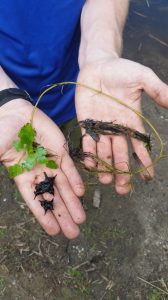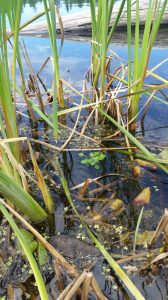WESTFIELD—A group from Silvio O. Conte National Fish and Wildlife Refuge, including several student interns, worked together to try and protect some of the city’s natural water habitat.
Interns from the Student Conservation Association (SCA), who were guided by the Silvio O. Conte National Fish and Wildlife Refuge—a part of the US Fish and Wildlife Service—and the Westfield Conservation Commission, worked to clear Brickyard Ponds off Root Road of water chestnut. The plant is an invasive species and conservation groups have been working to rid bodies of water of the plant before it ruins their ecosystems.
The work at Brickyard Ponds is part of an ongoing strategy to remove the species entirely from that area, or else the plant could do massive harm to the ecosystem there.
“We’ve removed 70 to 80 tons over time,” Karen Leigh, conservation coordinator for Westfield, said. “If we haven’t the wetlands would be taken over in one to two years.”
According to Cynthia Boettner, Invasive Plant Control Initiative Coordinator for the Silvio O. Conte National Fish and Wildlife Refuge, the plant is an invasive species that causes ecosystems to become hypoxic, or lack sufficient oxygen. If this happens, other flora and fauna within the system struggle to survive. The water chestnut’s main areas of growth are in shallow or slow-moving bodies of water, such as ponds or lakes.

An intern from the SCA holds the leaves and seeds from the water chestnut (L) in his hand, along with the root system (R) that is pulled out of the water
Part of the reason for this is its rapid proliferation. According to Boettner, one plant can produce 12.5 times as much of itself in one generation through germination. Also according to Boettner, the species may be able to arrive through water transportation down rivers and streams, but the likelier source is on the feathers of water fowl. The seeds, which are barbed, can become attached to feathers.
Boettner said that a total of 35 student interns from SCA came to remove the plant from the Brickyard Ponds, armed with buckets, gloves and canoes to reach the invasive species. They paddled out into the waters and reached in, pulling the plants out and made sure to capture the seeds, to try and make sure it wouldn’t later reproduce. Then, they deposited them onto dry land, where composting would break down the plants.
Boettner said that a total of 1,189 plants weighing 113 pounds were pulled from the ponds.
Brickyard Ponds is one of the several sites that Boettner and others go to throughout the year to try and remove the water chestnut.
Boettner said that if you believe that you see water chestnut in an area, then you can contact the Silvio O. Conte National Fish and Wildlife Refuge in Sunderland at 413-548-9725, or you may use the Outsmart Invasives mobile app.


